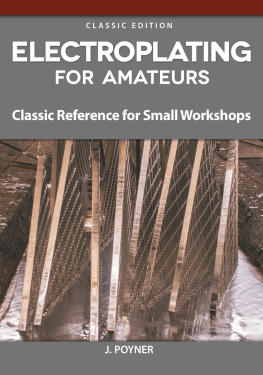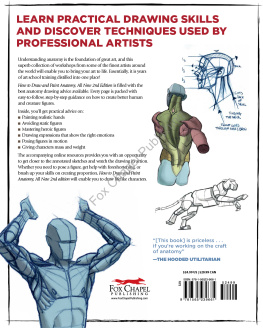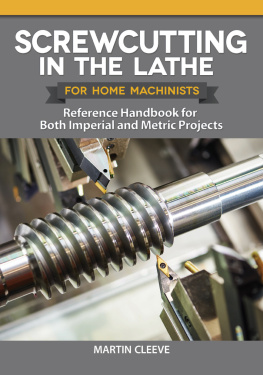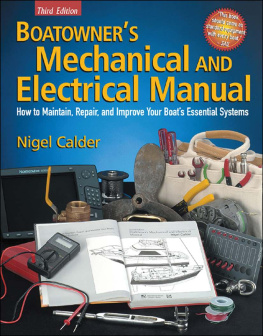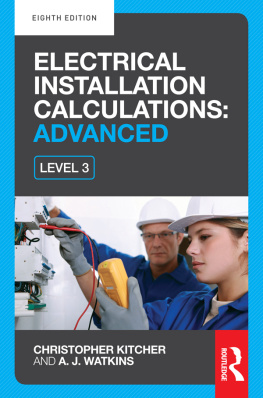Jack Poyner - Electroplating for Amateurs: Classic Reference for Small Workshops
Here you can read online Jack Poyner - Electroplating for Amateurs: Classic Reference for Small Workshops full text of the book (entire story) in english for free. Download pdf and epub, get meaning, cover and reviews about this ebook. year: 2021, publisher: Fox Chapel Publishing, genre: Children. Description of the work, (preface) as well as reviews are available. Best literature library LitArk.com created for fans of good reading and offers a wide selection of genres:
Romance novel
Science fiction
Adventure
Detective
Science
History
Home and family
Prose
Art
Politics
Computer
Non-fiction
Religion
Business
Children
Humor
Choose a favorite category and find really read worthwhile books. Enjoy immersion in the world of imagination, feel the emotions of the characters or learn something new for yourself, make an fascinating discovery.
- Book:Electroplating for Amateurs: Classic Reference for Small Workshops
- Author:
- Publisher:Fox Chapel Publishing
- Genre:
- Year:2021
- Rating:4 / 5
- Favourites:Add to favourites
- Your mark:
Electroplating for Amateurs: Classic Reference for Small Workshops: summary, description and annotation
We offer to read an annotation, description, summary or preface (depends on what the author of the book "Electroplating for Amateurs: Classic Reference for Small Workshops" wrote himself). If you haven't found the necessary information about the book — write in the comments, we will try to find it.
The complete classic manual to electroplating!
- Techniques for depositing a thin metallic layer on an object for decoration, corrosion protection, electrical conductivity, wear resistance, and more
- Valuable resource for amateurs, model engineers, and small workshops wishing to plate with any of the customary metals
- Author Jack Poyner is a professional model engineer involved in all forms of plating
- Classic edition is noteworthy historically, as its no longer common practice to electroplate as described
An insightful resource for home machinists and model engineers, Electroplating for Amateurs is a complete manual detailing the principles and practices of several forms and functions of plating.
Detailing the techniques of depositing a thin metallic layer on an object for decoration, corrosion protection, electrical conductivity, wear resistance, and more, this guide provides solutions for small workshops looking to plate with any of the customary metals using simple and inexpensive equipment. Although electroplating materials and methods are much improved from some shown inside this classic edition, it is still an incredibly useful resource for makers everywhere.
This 64-page classic handbook features an introduction to and the basic principles of electroplating as well as various fundamental techniques and insightful sections on electrical supply, the electroplating tank, cleaning the substrate, the electrolyte, electroforming and electroplating on non-conductors, electroless electroplating, the finishing of aluminum and its alloys, and more. Youll find helpful diagrams and charts throughout the book alongside the classic text.
Author Jack Poyner is a professional model engineer involved in all forms of plating. He is aware of whats valuable for beginners and what is best suited for experts, making this guide thoughtful, useful, and practical for amateurs.
Although no longer common practice to electroplate as described, this classic edition of Electroplating for Amateurs is a noteworthy resource for anyone involved in the trade!
The Home Machinist Series is filled with everything you ever wanted to know about machining and more. I feel quite confident that those who read the whole series, or even just one book, will come away with invaluable and extensive knowledge that will help further their craft.
Shawn Arnold, Publisher CNC WEST magazine
There is a wealth of insightful and easy-to-comprehend information for metalworkers in the Home Machinist Series. The books are guaranteed to serve as handy, long-term machining references.
Alan Richter, Editor at Large, Cutting Tool Engineering magazine
Jack Poyner: author's other books
Who wrote Electroplating for Amateurs: Classic Reference for Small Workshops? Find out the surname, the name of the author of the book and a list of all author's works by series.

